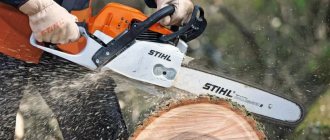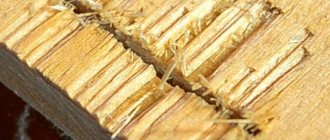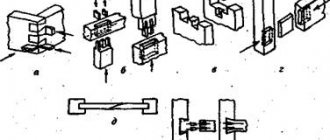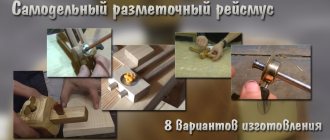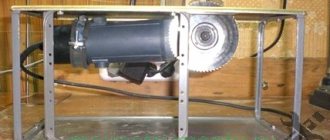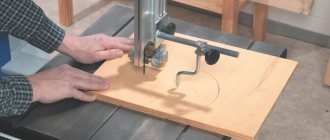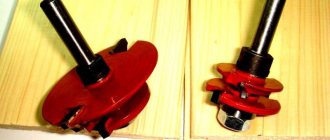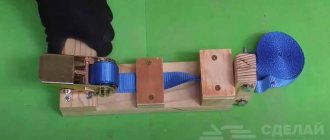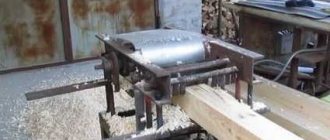Jigsaw device
The following short introduction was compiled to answer the question “What is a jigsaw” and “How does it work.”
Since this is only a superficial analysis of the tool, we will not dive into the technical depths, but will only touch on the external functionality. We assure you that the information provided will fully clarify the general understanding of the concept of the device and form a clear picture of the principle of its operation. First of all, you should pay attention to the shapes of jigsaws. They can be staple-shaped or straight with a mushroom-shaped handle. The first option is the most common and very convenient, but for the sake of fairness it is worth saying that working with a mushroom-shaped handle can be quite comfortable (especially in figured cutting).
Regardless of the shape of the handle, each jigsaw has a start button and its lock (for operation without holding). Also, any device of this type has a sole, which can be stamped or cast (on more expensive models). For miter cuts, the sole can be tilted using a key or lever installed on professional devices. Saw blades, making an average of 50 strokes per second, are installed in a special clamp, which can be a block, screw or quick-clamp.
Most modern models are equipped with a pendulum function (to speed up cutting), the regulator of which is located on the left side of the body, next to the file. If we look at the structure of a jigsaw in more detail, we will notice that some models may be equipped with a backlight, a dust collector, a laser pointer and other useful devices. We described these and other functions in detail in a separate article.
For more experienced users who understand the structure of power tools, the following jigsaw diagram has been laid out. The model of a domestic manufacturer presented in analysis clearly demonstrates all the components of the “filling” of most standard devices.
Selection principles
When choosing a tool you need to consider:
- Electric motor power. The higher it is, the more opportunities open to the master.
- Availability of power regulator. It is necessary when you need to frequently cut different materials.
- Possibility of adjusting the angle of the saw blade. This additional feature allows you to use the tool in hard-to-reach places.
- Platform material. If it is plastic, any fall may cause it to break. On sale you can find models with metal soles.
- Cable length. The bigger, the better.
- File type. You need to buy several types of equipment and paste for cooling the metal in advance.
When choosing a tool, you need to hold it in your hands to feel how convenient it is. Some modern models are equipped with a laser designator and a flashlight that illuminates the work area. These are optional functions, but they make the work process easier and allow you to make even cuts.
Jigsaw (Photo: Instagram / trudyagadv.ru)
Advantages and disadvantages
Advantages of jigsaws:
- The work process is simplified.
- You don't need to buy expensive industrial equipment to cut metal workpieces.
- Using a power tool you can make straight cuts.
- Compared with stationary units, using a jigsaw you can cut parts in hard-to-reach places.
Flaws:
- High price of equipment for power tools.
- Over time, the files become dull and break. You need to regularly buy new equipment.
- In order not to spoil the metal on the cuts, it is necessary to use a special cooling lubricant.
A jigsaw is necessary for builders and installers who work with metal, wood, and plastic.
Manufacturers and cost
In construction stores you can find tools for cutting metal, wood, and plastic from the following companies:
- Makita is a Japanese manufacturer of power tools. Produces high quality products.
- DeWalt is an American company that produces professional tools for construction work. The price is justified by quality, power, reliability.
- Bosch is a German manufacturer that produces tools for professionals and amateurs.
- Skil is a German manufacturer that produces power tools for construction. The products of this company are of good quality.
- Hitachi is a concern of 1,100 companies that develop equipment for large enterprises and produce power tools.
Among the budget manufacturers we can highlight Interskol, Diold, Zubr.
Jigsaw brand "Maquitta" (Photo: Instagram / joyridertools)
How to insert a file into a jigsaw
With intensive use or when working with different types of materials, it often becomes necessary to replace the saw blade. The types of saw blade mounts may differ on different models of jigsaws. To give the most detailed answer, we will consider each type of clamp separately. Block clamp
. Perhaps the simplest fastening of a file in a jigsaw, most often found in inexpensive copies. Consists of a block with two screws installed on the front side of the tool. It is universal, as it can fix saw blades with any shanks. When tightening this fastener, be careful and ensure that the file is level. To do this, tighten the screws evenly, a little each, and ideally check the evenness of the installed blade with a square.
Screw clamp
. A more convenient and reliable mount, although it has only one screw installed on the side. To figure out how to change a file on a jigsaw with this type of clamp, you don’t need to be a rocket scientist. All that is required is to loosen the fastening element with a screwdriver or wrench, remove the old file, install a new one and screw it back. The main thing is not to tighten the screw too much, otherwise the blade may “play” during operation.
Quick-release fastening
. The most convenient clamp for a file, found on more or less expensive models. Does not require a wrench or screwdriver and is only suitable for blades with certain types of shanks (depending on the tool model). To install a file, just pull back the special lever with your finger and insert a new blade into the groove. There are several types of levers: frontal, lateral and radial (demonstrated in the next video). Now that you know how to properly insert a file into a jigsaw, it’s time to move on to other, more practical things.
Tips for choosing saws
If a craftsman is interested in a decent result of his work, it is better to purchase files from trusted companies. They are a little more expensive, but already a reliable option. Inexpensive canvases wear out faster and break more often.
There is a more detailed classification of files:
- Т101В – for cutting plexiglass and plywood;
- Т101ВR – for laminated wood and laminate;
- T101D – for boards, timber, chipboard;
- Т224D – for working with aluminum;
- T118A – for sawing metal and plastic elements;
- T119VO – for shaped cutting on chipboard, laminated chipboard, fiberboard.
To know how to change a file on a jigsaw, you need to have one in stock that is suitable for cutting the prepared material.
The T-shank is considered the most common
How to cut a circle with a jigsaw
Sometimes, many beginners and even experienced owners of electric jigsaws ask the question “How to make a perfectly even circle with this tool.”
Tasks for accurate radius cutting do not appear often, and require a steady hand, ingenuity or financial expenditure from the operator. Below, we have given 3 ways to cut a circle with a jigsaw, starting from the most banal and ending with a rather interesting solution. With your own hands
. The most obvious, but very controversial option, for more or less experienced craftsmen. The speed in this case should be minimal, and it is better to install a vacuum cleaner near the workplace to promptly remove sawdust from the marking line. The evenness of the cut, in this case, depends only on the experience of the operator.
Compass
. Some brands of electric jigsaws can be equipped with additional auxiliary devices, one of which is a compass. Unfortunately, not every tool model presented in the store can be improved through a simple purchase, since the equipment from one manufacturer simply will not fit another. Not all manufacturers provide for the possibility of expanding the functionality of the devices they produce, so choosing a compass for a jigsaw of your particular brand can be quite problematic. By the way, such trinkets cost between 1000 and 7000 rubles.
Homemade compass
. Perhaps the best option for the home handyman. To create such a device, you only need a sheet of plywood of the size you need, a little PVA glue, and a dozen nails or clamps. With a device assembled from these materials, you can easily cut a hole in the countertop for a round sink with a jigsaw, cut out an opening for a decorative window, and make many perfectly even holes wherever you want. You can watch the detailed process of making a jigsaw compass in the video below.
The most common breakdowns and methods for their prevention
High-quality jigsaws have a fairly long service life. But even the best models can suddenly fail. The most common tool parts that fail are:
- Start button. Basically, such a design element stops working when metal dust gets into the housing. To eliminate the problem, you need to perform simple cleaning using a special vacuum cleaner. With prolonged use of an electric jigsaw, the button fails as the mechanism wears out.
- Mechanical connections. Most often the rod gets damaged. This element is most affected by mechanical loads. The locking device, which is connected to the rod, often fails. This is all due to dust getting inside the housing while cutting various materials. But if the instrument has a high-quality body, then such problems practically do not arise.
- Engine. Stopping the electric driving mechanism can occur when the stator or rotor burns out. Also, sometimes the problem occurs due to wear on the notch on the shaft. In order for an electrical device to work long enough, its power should always be taken into account before setting certain tasks.
Working with wood
Despite its solid functionality, an electric jigsaw is most often used to work with wood and its derivatives. The use of this device is always justified: from rough cutting of tens of meters of chipboard or timber, to delicate processing of laminate or plywood.
There is nothing tricky about how to work with a jigsaw: you press the start button and start processing the selected material. The most important thing is to carry out the work cleanly, evenly and as necessary, without chips. To make working with a jigsaw on wood successful, it is enough to know a few simple rules. Speed
. When working with wood, the maximum number of revolutions is permissible. If you need a more even cut, without chips, the speed is reduced. The optimal speed mode is set depending on the material being processed. If excess chips form on the surface, it is better to reduce the speed or change the saw blade.
Files
. For rough cuts and thick wood, a saw with large teeth with an average pitch of 4 mm is suitable. More delicate straight cutting operations are best carried out with a blade with finer teeth and reverse sharpening is better. For shape cutting, it is better to use a thin file with large teeth.
Cut without chips
. When an electric jigsaw is used to work with wood and its derivatives, the cutting line is almost always accompanied by unpleasant chips that spoil the overall appearance of the product. This defect is especially noticeable and undesirable on decorative and facing materials. Fortunately, there is a very simple and effective solution to this problem, called an “Anti-Splinter Liner”.
This compact plexiglass device is installed in the sole of some jigsaw models and prevents the saw blade from tearing out pieces of material during operation. It should be noted that this method provides a clean cut only with files whose teeth are directed upward. Unfortunately, not every manufacturer produces such inserts, and they are not universal.
If such an improvement is not provided for your jigsaw model, you can make it yourself from a piece of plywood or plexiglass. The video below “how to work with a jigsaw on wood without chipping” clearly demonstrates the process of making such an improvised liner.
A little trick. If you need to make a clean cut, but there is no liner and it is not possible to make your own, ordinary tape can come to the rescue. Just stick a strip along the cut line and it will be much neater.
Additional tips for choosing saws
The quality of the saw blades should be even better than the quality of the jigsaw itself, because it is the dull teeth that easily bend in different directions that can ruin the work of even the most experienced craftsman.
In addition, it makes sense to choose different saws for different types of cutting:
- For straight cuts, wide blades are suitable, they have greater stability and, accordingly, ensure a straight line in the end.
- The more important the cleanliness of the cut itself, the finer the teeth on the blade are selected.
- If it is necessary to achieve a perfectly clean cut line, absolutely without a single chip, choose a blade that has a reverse tooth stroke.
- When there is a need for quick and rough cutting, large saws with widely spaced cutters are used.
- Saws without routing are quite productive and convenient for working with thick workpieces.
- If both productivity and cutting quality are equally important, then saws with teeth installed with a displaced pitch will help (at the bottom the pitch is large, and as it approaches the front part of the part it gradually becomes smaller).
Metal cutting
Not every file can cope with the strong structure of metals such as steel and even aluminum. To make your work with this material most effective, just follow simple rules.
- Set the minimum frequency of saw strokes. Unlike wood, where working at maximum speed is permissible, the dense structure of the metal will simply dull saws even with the strongest teeth. In this case, the presence of a regulator will be very useful, which will eliminate the need to buy a special electric jigsaw for metal.
- Use saw blades marked HSS (High Speed Steel). There are many types of canvases, and before purchasing, you should have a clear understanding of the thickness and density of the material you will be working with. For soft, sheet aluminum, the usual T118A is suitable, and for cutting steel, 3-6 cm thick, a T118B metal jigsaw file is suitable. Where is the first letter “T”, the name of the shank, which may not fit your instrument (more details about fasteners are written above).
Terms of use
Almost everyone knows the general rules of how to use a jigsaw, but there are many important features in working with this device. Of course, it all depends on the material the power tool is working with, but below are some general guidelines.
Tips on how to use a jigsaw:
- There is no need to press in the direction of the cut; the jigsaw should move freely on its own. If the tool does not work, the file is dull. If you put too much pressure on the file, it will move to the side and ruin the cut.
- Here's how to properly use a jigsaw for finishing sawing: the pendulum stroke is set by the regulator to 0, and if thicker boards are being cut in the direction of the grain, then the regulator is set to 1.
- The pendulum mode is used when cutting along the fiber, helping the file not to go to the side.
- During operation, the part must be fixed using clamps. Since you can work with a jigsaw with one hand, some novice specialists, in order to save time, hold the part itself in the second. But in this position it will be impossible to guide the power tool in a straight line. For a more accurate cut and work safety, the part is fixed.
- During work, a lot of dust and sawdust is generated in a short period of time, so using glasses for protection will not be superfluous. If a splinter (especially a metal one) gets into the eye, not only the cut will be damaged, but also the vision.
- In the rules on how to use a jigsaw, it is impossible not to mention that you need to cut not along the intended line, but nearby. This way the cut comes out more accurately and when marking you can avoid including a tolerance for the cut itself.
- To make the cut on the front side smoother and more beautiful, the part is placed face down while working. However, this rule does not apply in the case of thick workpieces. And if there are doubts about the possibility of strictly maintaining the markings on the reverse side in this way, then it is better to use special inserts.
- Sometimes just using a jigsaw as your main tool is not enough. You need to choose the most suitable tool for each manipulation. For example, in woodworking, if the task is simply to saw straight through a long piece in the direction of the grain, a circular saw (if available, of course) or a hacksaw would be more appropriate than a jigsaw. After all, a hacksaw, although rougher, cuts more straight.
- When sawing metal workpieces, it is advisable to use the maximum stroke frequency and turn off the pendulum mechanism altogether.
- How to use a jigsaw from the experience of professionals when working with plastic? It can be taken into account that a high frequency during the cutting process leads to melting, so you need to choose the lowest possible frequency.
- To make the cut exactly straight, you can use a guide limiter. Such a device is attached to the base of the power tool and pressed against the edge of the part.
- If you have to deal with pattern cutting, then first drill a hole for the saw at the point where the marking begins. The saw is inserted into this hole and cutting begins in accordance with the markings.
- To cut a bevel, you need to know how to use a jigsaw at an angle: for this purpose, they have provided the ability to tilt the sole at whatever specific angle is intended.
- When the jigsaw is powered, it is very important to ensure free movement of the cable.
The quality of the saw blades should be even better than the quality of the jigsaw itself, because it is the dull teeth that easily bend in different directions that can ruin the work of even the most experienced craftsman.
In addition, it makes sense to choose different saws for different types of cutting:
- For straight cuts, wide blades are suitable, they have greater stability and, accordingly, ensure a straight line in the end.
- The more important the cleanliness of the cut itself, the finer the teeth on the blade are selected.
- If it is necessary to achieve a perfectly clean cut line, absolutely without a single chip, choose a blade that has a reverse tooth stroke.
- When there is a need for quick and rough cutting, large saws with widely spaced cutters are used.
- Saws without routing are quite productive and convenient for working with thick workpieces.
- If both productivity and cutting quality are equally important, then saws with teeth installed with a displaced pitch will help (at the bottom the pitch is large, and as it approaches the front part of the part it gradually becomes smaller).
Plastic cutting
A fairly fragile and at the same time elastic (depending on the purpose) material, which also has a fairly low melting point. To understand once and for all how to properly cut plastic with a jigsaw, you should know only 2 simple rules.
- It is better to keep the cutting speed below average. Of course, plastic does not have the hardness of metal to deform the teeth of a saw blade, but a high stroke rate can simply melt it.
- There are special files for working with this material, but if they are not available, you can use standard ones for wood or metal. Suitable files for cutting are T101A (where A is a small tooth), T101B (B is a larger tooth) and T101X (X is universal for wood, plastic and metal).
Step-by-step instructions for curved cutting
If with a straight cut everything is more or less clear, then for pattern cutting you will have to “sweat a little”.
Stages of curved cutting:
A file is selected. When the degree of rounding is not particularly large, then the standard version of the canvas is suitable. In case of sharper rounding, it is necessary to use narrower blades
However, here too it is important to find a middle ground, because an excessively narrow blade will resist being pulled to the side during the cutting process. As mentioned earlier, the cut begins with drilling a hole for the saw. If the radius is small, then during the work you will need to keep a reference point depending on the position of the canvas, because all sorts of marking points can lead you off the required course. Moving along the marking, the jigsaw is guided, turning around the axis of the part. No lateral force required
You cannot push the tool forward - it must move calmly.
https://youtube.com/watch?v=XfMH7LWuwKE
Safety precautions
Being even the most experienced craftsmen who have studied the tool inside and out, we, by chance, can be exposed to harmful influences during its operation. We are also talking about banal cuts, severed limbs, loss of vision, and less predictable effects associated with hearing loss and nervous system disorders with all that entails. It may seem that safety rules when working with a jigsaw are mostly needed by professionals who work with this device for several hours a day. We recommend that everyone try to follow the rules below at all times.
- Protective means. Safety glasses, gloves, respirator, earmuffs and a hat if the operator has long hair.
- Safety precautions with an electric jigsaw strictly prohibit using the tool while under the influence of alcohol or drugs, as well as under the influence of medications that affect attention and concentration. Stress or sleepiness can also cause injury.
- Before use, check the condition of the electric jigsaw. Make sure that there is no obvious damage to the cable or device body. Holding the jigsaw suspended, turn it on and press the start button to check the serviceability of the mechanism.
- When using an electric jigsaw, place your free hand to the side of the direction of the tool, but not in front of it. Do not point the jigsaw sideways or towards you. The movement of the tool during work should be directed only away from you. Make sure that the electrical cable does not get caught under the running saw blade.
- Upon completion of work, unplug the jigsaw, clean the body of sawdust and check for damage. Do not leave the tool on the floor, but put it in a dry and preferably ventilated place.
article from the Rating section
- 80
Power tools Carpentry tools (for wood) For working with metal Tools for ceramics
Save this page on your social media. network and return to it at any time.
ADD A COMMENT
Jigsaw care
Like any mechanism, a jigsaw requires care and maintenance. Especially if you use it frequently and intensively.
Practice shows that to increase the service life of a jigsaw, you need to regularly lubricate the gearbox and rod. In addition, lubricated tools are quieter and smoother.
The jigsaw motor shaft rotates on ball bearings. They are durable and can work without additional lubrication for the entire service life of the tool. But a jigsaw is not only an electric motor.
The rotation of the shaft is converted by a special mechanism into a reciprocating movement of the jigsaw rod. The pumping device adds longitudinal vibrations of the rod back and forth to these up and down movements. All this complex mechanics is assembled on plain bearings. The loads from the working nozzle are transferred to them. It’s a no brainer that lubrication is a vital component here.
For jigsaws, consistent types of lubricant are used. They must be sufficiently refractory. During operation, the mechanism heats up from friction in the nodes and from nearby electrical windings of the motor. In this case, ordinary lubricants are liquefied and squeezed out of the friction pairs.
We have selected a video for you that shows disassembling a jigsaw for subsequent lubrication:
